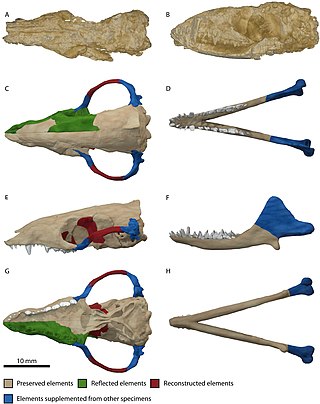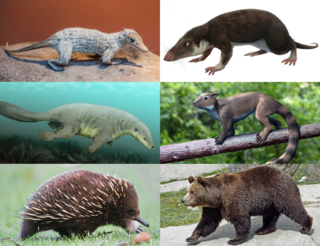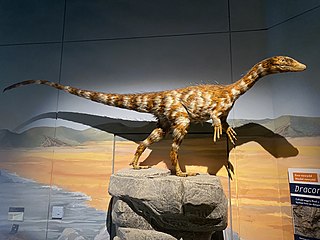
Morganucodon is an early mammaliaform genus that lived from the Late Triassic to the Middle Jurassic. It first appeared about 205 million years ago. Unlike many other early mammaliaforms, Morganucodon is well represented by abundant and well preserved material. Most of this comes from Glamorgan in Wales, but fossils have also been found in Yunnan Province in China and various parts of Europe and North America. Some closely related animals (Megazostrodon) are known from exquisite fossils from South Africa.
The Early Jurassic Epoch is the earliest of three epochs of the Jurassic Period. The Early Jurassic starts immediately after the Triassic–Jurassic extinction event, 201.3 Ma, and ends at the start of the Middle Jurassic 174.7 ±0.8 Ma.

Mammaliaformes is a clade that contains the crown group mammals and their closest extinct relatives; the group radiated from earlier probainognathian cynodonts. It is defined as the clade originating from the most recent common ancestor of Morganucodonta and the crown group mammals; the latter is the clade originating with the most recent common ancestor of extant Monotremata, Marsupialia, and Placentalia. Besides Morganucodonta and the crown group mammals, Mammaliaformes includes Docodonta and Hadrocodium.

Gobiconodon is an extinct genus of carnivorous mammals belonging to the family Gobiconodontidae. Undisputed records of Gobiconodon are restricted to the Early Cretaceous of Asia and North America, but isolated teeth attributed to the genus have also been described from formations in England and Morocco dating as far back as the Middle Jurassic. Species of Gobiconodon varied considerably in size, with G. ostromi, one of the larger species, being around the size of a modern Virginia opossum. Like other gobiconodontids, it possessed several speciations towards carnivory, such as shearing molariform teeth, large canine-like incisors and powerful jaw and forelimb musculature, indicating that it probably fed on vertebrate prey. Unusually among predatory mammals and other eutriconodonts, the lower canines were vestigial, with the first lower incisor pair having become massive and canine-like. Like the larger Repenomamus there might be some evidence of scavenging.

Leptonectes is a genus of ichthyosaur that lived in the Late Triassic to Early Jurassic. Fossils have been found in Belgium, Germany, Switzerland, Spain and the United Kingdom. The type species, L. tenuirostris, reached 4 metres (13 ft) long, while L. moorei reached 3 metres (9.8 ft) long; the largest species, L. solei, was approximately 5–6 metres (16–20 ft) long.

Morganucodonta is an extinct order of basal Mammaliaformes, a group including crown-group mammals (Mammalia) and their close relatives. Their remains have been found in Southern Africa, Western Europe, North America, India and China. The morganucodontans were probably insectivorous and nocturnal, though like eutriconodonts some species attained large sizes and were carnivorous. Nocturnality is believed to have evolved in the earliest mammals in the Triassic as a specialisation that allowed them to exploit a safer, night-time niche, while most larger predators were likely to have been active during the day.

The Blue Lias is a geological formation in southern, eastern and western England and parts of South Wales, part of the Lias Group. The Blue Lias consists of a sequence of limestone and shale layers, laid down in latest Triassic and early Jurassic times, between 195 and 200 million years ago. The Blue Lias is famous for its fossils, especially ammonites.
Triconolestes is an extinct genus of Late Jurassic eutriconodont mammal from the Morrison Formation, present in stratigraphic zones 4. Known from only a single molar, it is a small mammal typically considered an amphilestid. However, it has also been compared to Argentoconodon, which has been considered a volaticothere related to gliding mammals such as Volaticotherium and Ichthyoconodon.

Triconodontidae is an extinct family of small, carnivorous mammals belonging to the order Eutriconodonta, endemic to what would become Asia, Europe, North America and probably also Africa and South America during the Jurassic through Cretaceous periods at least from 190–66 mya.
Amphilestidae is a family of Mesozoic mammals, generally regarded as eutriconodonts. They may form a paraphyletic or polyphyletic assemblage, though they share with gobiconodontids their similar tooth occlusion patterns and may be especially closely related to them. They occur from the Middle Jurassic to Cenomanian, and have a distribution across Laurasia.
Paleontology or palaeontology is the study of prehistoric life forms on Earth through the examination of plant and animal fossils. This includes the study of body fossils, tracks (ichnites), burrows, cast-off parts, fossilised feces (coprolites), palynomorphs and chemical residues. Because humans have encountered fossils for millennia, paleontology has a long history both before and after becoming formalized as a science. This article records significant discoveries and events related to paleontology that occurred or were published in the year 2011.
Bridetherium is an extinct genus of morganucodontan from Early Jurassic deposits of southern Wales, United Kingdom. Bridetherium is known from some isolated upper and lower molariform. It was collected in the Pant Quarry, Vale of Glamorgan. It was first named by William A. Clemens Jr. in 2011 and the type species is Bridetherium dorisae. The species name is in honour of early mammal paleontologist Doris Mary Kermack.
Doris Mary Kermack FLS was a British paleontologist and marine zoologist at Imperial College London. She completed her PhD thesis entitled 'The anatomy and physiology of the gut of Arenicola marina L.' at University College London in 1953. In 1988 she was awarded the Linnean Gold Medal for outstanding service to the society. She had two sons with her husband and fellow paleontologist Kenneth Kermack.
Argentoconodon is an extinct genus of theriimorph mammal from the Cañadón Asfalto Formation of the Cañadón Asfalto Basin in Patagonia. When originally described, it was known only from a single molariform tooth, which possessed a combination of primitive and derived features. The tooth is currently held in the Museo Paleontológico Egidio Feruglio, where it was given the specimen number MPEF-PV 1877. New material described in 2011 show that Argentoconodon was similar to Ichthyoconodon, Jugulator and Volaticotherium within the family Triconodontidae, and possibly also Triconolestes.
Condorodon is a genus of extinct mammals from the Lower Jurassic Cañadón Asfalto Formation of the Cañadón Asfalto Basin in Patagonia, Argentina. The type species is C. spanios, described by Gaetano and Rougier in 2012.
Denise Sigogneau-Russell is a French palaeontologist who specialises in mammals from the Mesozoic, particularly from France and the UK. She is currently based at the Muséum National d'Histoire Naturelle.
Storchodon is an extinct genus of morganucodont mammaliaforms from the Late Jurassic (Kimmeridgian) of Germany. Its only species is Storchodon cingulatus, which is known exclusively from a single upper molar found at the Süntel Formation of Lower Saxony.
Hallautherium is an extinct genus of morganucodont mammaliaforms from the Late Triassic of Europe. The type species H. schalchi is known from the Klettgau Formation of Switzerland. In addition, a molariform tooth referable to the genus has been found in Poland.
Indotherium is an extinct genus of mammaliaforms that lived in what is now India during the Early Jurassic. It contains one species, I. pranhitai, which is known from two upper molar teeth found in the Kota Formation of Telangana. When it was first described, it was assigned to the paraphyletic group "Symmetrodonta", but later studies have reinterpreted it as a possible member of the family Morganucodontidae.

Palaeontology in Wales is palaeontological research occurring in Wales.











